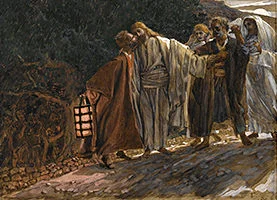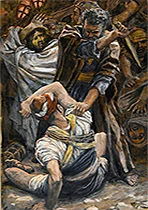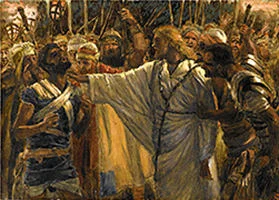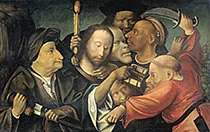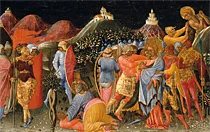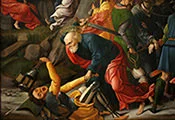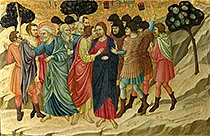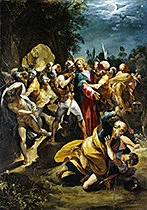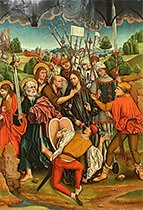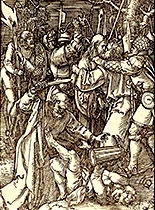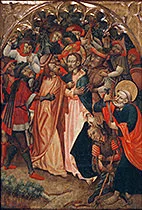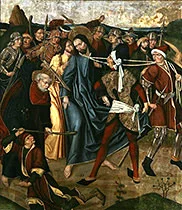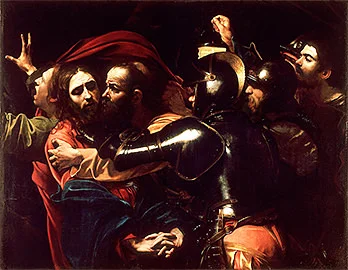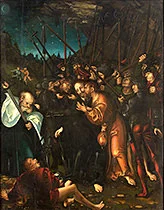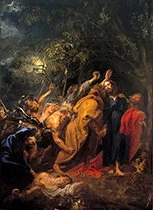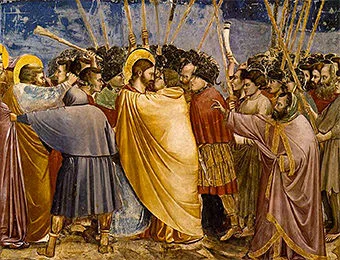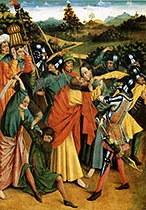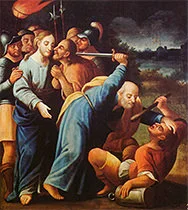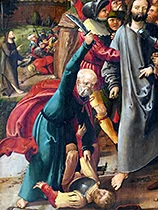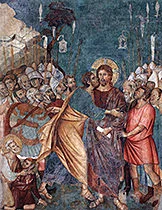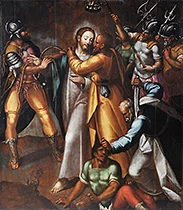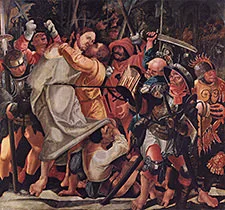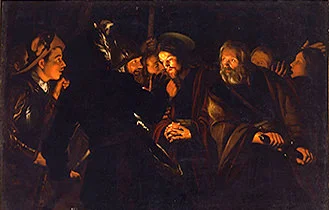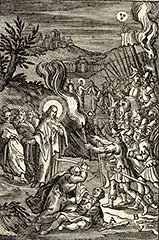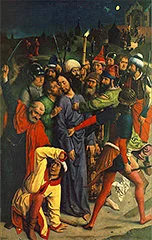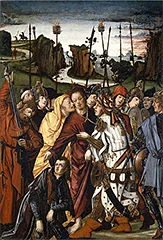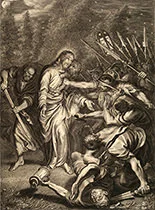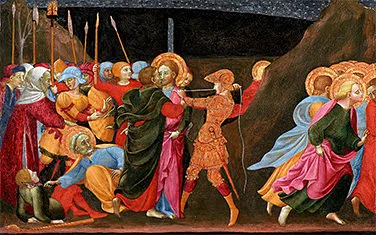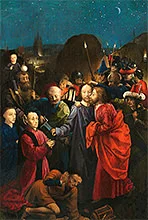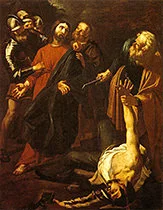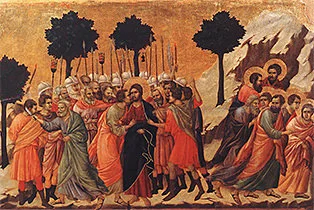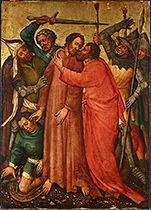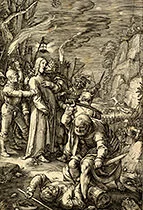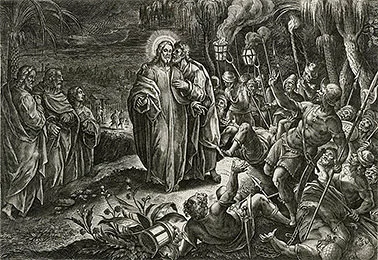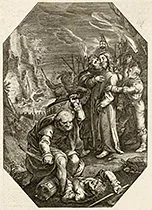The Art World Commemorates Peter
— Album 14 of 17 Photo Albums —
Warren Camp’s presentation of 550 famous “Peter” works of art includes historic paintings, frescoes, stained glass, etchings, sculptures, engravings, and other artwork monuments. They come from the Gothic (1100–1400), High Renaissance, Baroque, Rococo, Neoclassical, and Romantic (1800s) eras.
All are popular works, designed and created by celebrated artists, many of whom you’ll likely recognize, including Rembrandt, Raphael, Michelangelo, El Greco, Da Vinci, Masaccio, Huret, Galle, Tissot, Botticelli, Dürer, Rubens, and many more. They’ll bring back recollections of your “Art History 101” classes, using Janson’s History of Art textbook.
Whether depicting “Cephas,” “Petrus,” “Simon,” “Simeon,” “Simon Bar-Jonah,” “Simon Peter,” “The Rock,” “Peter,” “Apostle Peter,” or “Saint Peter,” the enlarged images of this acclaimed Bible figure come with factual and enlightening details: the artist’s bio; when each work was created; where it can be seen; applicable Bible passages; background and highlights of each work; and photo sources with copyright notices.
To appreciate the impact that Peter had on numerous art-world masters, be sure to click each thumbnail to enlarge it.
• These photo albums complement the Bible-study commentaries Warren has written for “1st and 2nd Peter,” found here.
…
Album 1 (Peter, alone) | Album 2 | Album 3 | Album 4 | Album 5
Album 6 | Album 7 | Album 8 | Album 9 | Album 10 | Album 11
Album 12 | Album 13 | Album 14 | Album 15 | Album 16 | Album 17
Album topics are shown at the [ ⇓ bottom ⇓ ] of each page.
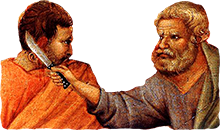
Judas’ Kiss • Jesus’ Arrest • Malchus’ Ear
Slide 16
Click to enlarge.
Giotto di Bondone, c. 1305–1306, painted fresco
Slide 19
Click to enlarge.
Wolgemut, 1506–1508
painted altarpiece
Slide 23
Click to enlarge.
Gerard Seghers or Adam de Coster — 1600–1650
oil on canvas
Slide 29
Click to enlarge.
Il Sassetta (Stefano di Giovanni) — 1437–1444
tempera, silver and gold leaf, on poplar panel
“L'Arrestation du Christ”
Slide 30
Click to enlarge.
Master of Dreux Budé
c. 1450 — oil on oak
with the Malchus Episode”
Slide 31
Click to enlarge.
Dirck van Baburen
1616–1617
oil on canvas
Slide 33
Click to enlarge.
Meister des Andreasaltars
1445–1450
paint on fir panel
Slide 35
Click to enlarge.
Philips Galle, 1585–1586
engraved print, after Jan van der Straet
- 1. “The Kiss of Judas,” watercolor on wove paper, by James Tissot, 1886–1894
[ James Tissot (French, 1836–1902): “The Kiss of Judas (Le Baiser de Judas),” 1886–1894. Brooklyn Museum, purchased by public subscription, 00.159.234 (Photo: Brooklyn Museum, 00.159.234_PS1.jpg); see Tissot’s “Life of Christ” collection of 124 watercolors selected from a set of 350 that depict detailed New Testament scenes.]
Jacques-Joseph Tissot was “born in 1836, in Nantes, a seaport on the French coast. In 1856 Tissot went to Paris to train as a painter where he anglicized his Christian name to James to draw attention to himself. He experienced a profound religious experience and became increasingly devout.”[1]
The Kiss of Judas “Having betrayed Jesus, Judas leads a party of armed temple guards who intend to arrest him. Judas has alerted the authorities that he will identify Jesus for them by kissing him. Above, Tissot presents Judas standing on tiptoes, reaching up to kiss Jesus. This is an intimate gesture that further underscores the bitterness of the betrayal.”[2]
We find in Matthew 26:48–50 the scriptural text of Judas betraying Jesus with a kiss…“Now the betrayer had arranged a signal with them: ‘The one I kiss is the man; arrest him.’ Going at once to Jesus, Judas said, ‘Greetings, Rabbi!’ and kissed him. Jesus replied, ‘Do what you came for, friend.’ Then the men stepped forward, seized Jesus and arrested him.”
… Height: 8 1/16 in. (20.5 cm), width: 10 11/16 in. (27.1 cm)
… Photo source, license, attribution, museum details, and image enlargement: Brooklyn Museum
… The artist’s short biography; his other works of art
Return to “Peter Masterpieces” album’s opening page or to the top of this page or open the next album. - 2. “The Ear of Malchus,” watercolor on wove paper, by James Tissot, 1886–1894
[ James Tissot (French, 1836–1902): “The Ear of Malchus (L'oreille de Malchus),” 1886–1894. Brooklyn Museum, purchased by public subscription, 00.159.238 (Photo: Brooklyn Museum, 00.159.238_PS1.jpg); see Tissot’s “Life of Christ” collection of 124 watercolors selected from a set of 350 that depict detailed New Testament scenes.]
Jacques-Joseph Tissot was “born in 1836, in Nantes, a seaport on the French coast. In 1856 Tissot went to Paris to train as a painter where he anglicized his Christian name to James to draw attention to himself. He experienced a profound religious experience and became increasingly devout.”[1]
One of Jesus’ disciples — Simon Peter, armed with a sword — cut off an ear of someone, in an attempt to prevent Jesus’ arrest. Only in Luke’s gospel account does Jesus touch and heal the severed right ear that an unnamed disciple had cut from the head of an unnamed servant of a high priest (Luke 22:50–51). And only in John’s gospel are the two unnamed persons identified: Simon Peter and Malchus, respectively (John 18:10). All four gospels reveal that, during Jesus’ arrest in Gethsemane, a disciple cut off an ear of a high priest’s servant (Matthew 26:50–51; Mark 14:47; Luke 22:49–51; and John 18:10–11).
Many artwork images pair the presentations of (a) Peter’s attack of a doomed servant with (b) Jesus’ prompt healing of that wound. So, to accompany his The Ear of Malchus “attack” painting (above), Tissot’s “healing” depiction [see next slide] appears in its own watercolor rendering titled The Healing of Malchus. Note: This ear-wound healing was Jesus’ last recorded miracle that he performed during his earthly ministry, prior to his death and resurrection.
… Height: 7 3/16 in. (18.3 cm), width: 4 11/16 in. (11.9 cm)
… Photo source, license, attribution, museum details, and image enlargement: Brooklyn Museum
… The artist’s short biography; his other works of art
Return to “Peter Masterpieces” album’s opening page or to the top of this page or open the next album.
- 3. “The Healing of Malchus,” watercolor on wove paper, by James Tissot, 1886–1894
[ James Tissot (French, 1836–1902): “The Healing of Malchus (La Guérison de Malchus),” 1886–1894. Brooklyn Museum, purchased by public subscription, 00.159.239 (Photo: Brooklyn Museum, 00.159.239_PS1.jpg); see Tissot’s “Life of Christ” collection of 124 watercolors selected from a set of 350 that depict detailed New Testament scenes.]
Jacques-Joseph Tissot was “born in 1836, in Nantes, a seaport on the French coast. In 1856 Tissot went to Paris to train as a painter where he anglicized his Christian name to James to draw attention to himself. He experienced a profound religious experience and became increasingly devout.”[1]
After praying three times that night in Gethsemane, Jesus said to his disciples, “Rise! Let us go! Here comes my betrayer!” (Mark 14:42). A large crowd, carrying torches, lanterns, and weapons was looking for Jesus so they could arrest him. Judas led the detachment of soldiers, temple guards, teachers of the law, and elders. When the crowd arrived to arrest Jesus, Judas gave Jesus his prearranged betrayal kiss. Prior to the arrest, Peter, wanting to protect Jesus, drew his sword and cut off the ear of Malchus, servant of the high priest (John 18:10), as shown in the previous slide of Tissot’s watercolor titled The Ear of Malchus.
Above, in this third successive Tissot painting titled The Healing of Malchus, Jesus miraculously restores the servant’s ear after telling Peter to put away his sword (Matthew 26:52). Subsequently, Jesus was arrested. Note: This ear-wound healing was Jesus’ last recorded miracle that he performed during his earthly ministry, prior to his death and resurrection.
… Height: 5 1/4 in. (13.3 cm), width: 7 5/8 in. (19.4 cm)
… Photo source, license, attribution, museum details, and image enlargement: Brooklyn Museum
… The artist’s short biography; his other works of art
Return to “Peter Masterpieces” album’s opening page or to the top of this page or open the next album.
- 4. “The Arrest of Christ,” oil on oak panel, painted by Jheronimus Bosch, 1530–1550
The Arrest of Jesus was painted by Jheronimus Bosch (manner of). This painting is at the Rijksmuseum Amsterdam. It says this about this painting’s title and contents. “The Captivity of Christ by the Burning Torch…By the light of a torch, Christ is being arrested by a soldier on the left, drawing his dagger. On the right, Peter, clad in a red robe, is waving his dagger over the head of Malchus, who is biting Peter’s arm and warding him off by thrusting a lantern into his face. To the right of Christ’s resigned countenance [center] is the repulsive head of Judas and two other men.”[1] See many more Rijksmuseum Amsterdam’s Christian paintings and view numerous “Capture of Christ” paintings.
Chapter 18 of John’s gospel moves from Jesus’ Last Supper prayer, which he prayed to Father God in the upper room, directly to Gethsemane (Hebrew for “olive press”), a garden that he and his disciples entered often. In Luke’s account, we learn that Jesus and his disciples had repeatedly spent the night there on the Mount of Olives (Luke 21:37; 22:39).
The detachment of soldiers and officials from the chief priests and the Phariseese who came to arrest Jesus said that they sought Jesus of Nazareth. When he replied, “I am he,” his listeners fell to the ground (John 18:5–6). Reading John’s eyewitness account further, it’s clear that none of these events took Jesus by surprise; he knew what was to happen. Although he was the one arrested, tried, and ultimately crucified, he was always in the know and clearly in charge.
… Height: 20.2 in. (51.2 cm), width: 31.8 in. (80.8 cm)
… Photo source, license, attribution, museum details, and image enlargement: public domain, via Rijksmuseum Amsterdam
Return to “Peter Masterpieces” album’s opening page or to the top of this page or open the next album. - 5. “The Betrayal of Christ,” tempera on wood, painted by Bartolomeo di Tommaso, c. 1445–1450
Bartolomeo di Tommaso, also known as Bartolomeo da Foligno because he was born in Foligno, was an Italian painter of the Umbro-Sienese school. Bartolomeo was very influential in his lifetime but has begun to receive serious scholarly attention only within the past few decades.
In this Betrayal of Christ altarpiece painting, the artist has placed Jesus (right-center, wearing a halo) being kissed by Judas while also being grabbed by a soldier or member of the temple guard. Peter (front-center) is on his knees, attacking Malchus, the servant of the high priest. In the upper-right corner we see two men wearing a halo: The young man standing behind the boulder appears to be the unclothed man that Mark writes about in his gospel: “A young man, wearing nothing but a linen garment, was following Jesus. When they seized him, he fled naked, leaving his garment behind” (Mark 14:51–52). The other haloed man (far-right) isn’t identifiable by scriptural accounts.
Regarding Christ’s betrayal, it’s essential to understand who Judas Iscariot the betrayer was. “He was one of the original twelve disciples who followed and were taught by Jesus. Being in Jesus’ ‘inner circle,’ Judas had a closer relationship to Jesus than most people during His ministry. Judas betrayed the Lord to the Jewish authorities. The prearranged signal was that the person whom Judas kissed was to be arrested and taken away (Mark 14:44). In this way the Son of Man was betrayed with a kiss (Luke 22:48).”[1]
… Height: 8 3/4 in. (22.2 cm), width: 17 in. (43.2 cm)
… Photo source, license, attribution, museum details, and image enlargement: via The Met; Gwynne Andrews Fund, 1958
… The artist’s biography could not be found; see his other works of art
Return to “Peter Masterpieces” album’s opening page or to the top of this page or open the next album. - 6. “The Arrest of Christ,” oil on walnut panel, painted by Grégoire Guérard, c. 1520
This oil painting on a walnut panel, titled The Arrest of Christ, was painted by Grégoire Guérard around 1520. He was a Dutch painter active in France in the first half of the 16th century.
“We recognize in the foreground the violent episode of Peter cutting off Malchus’ ear. The scene was borrowed almost verbatim from Albrecht Dürer’s wood engraving from his ‘Great Passion’ collection, dated 1510, representing the ‘Arrest of Christ’ [shown on slide 10 of this album]. Despite some variations of detail, the artist respected the scheme of Dürer’s motif: the brandished sword, Peter grabbing Malchus’ arm while he was overturned on the ground, holding up a lantern in his hand.”[1]
Can you find Judas herein? He’s the bearded man wearing yellow (center), facing Jesus as he departs the arrest; in his left hand he carries his coin purse that holds the thirty pieces of silver that he received after agreeing to betray Jesus (Matthew 26:14–16).
Guérard made an effort to present the preceding episode leading up to Jesus’ arrest: his agonizing prayer effort in Gethsemane. Behind and to the left of the central boulder, the artist has placed Peter with James and John, asleep in Gethsemane, while above them Jesus lifts up his arms toward an angel in light.
… Height: 40.7 in. (103.4 cm), width: 36.9 in. (93.6 cm)
… Photo source, license, attribution, and image enlargement: Musée des Beaux-Arts de Dijon, CC BY-SA 2.0 FR, via Wikimedia Commons
… The artist’s short biography; his other works of art
Return to “Peter Masterpieces” album’s opening page or to the top of this page or open the next album.
- 7. “The Betrayal of Christ,” egg tempera on poplar panel, painted by Ugolino di Nerio, c. 1325–1328
Ugolino di Nerio’s The Betrayal of Christ “is one of four panels in National Gallery’s collection. It comes from the lowest part (the predella) of an altarpiece that was made for the church of Santa Croce in Florence. It focused on the Passion of Christ (his torture and crucifixion) and his Resurrection. The painting shows the moment, described in the gospels, when Jesus was arrested by Jewish temple guard members who’d been sent by the high priest to make the arrest. The temple guards are on the right, wearing elaborate armor; their helmets were originally silver but the silver leaf has darkened over time.
“The predella ran along the bottom of the entire altarpiece and was, as was usual, originally painted on one horizontal panel. This was the second scene on the predella. Before the painting entered The National Gallery’s collection, the eyes of the members of the temple guard (right) were damaged — most probably deliberately.
“The arrest was organized by Christ’s disciple, Judas Iscariot. We see him in the center of the scene, kissing Jesus on the cheek— a prearranged signal for the authorities: ‘Now the betrayer had arranged a signal with them: ‘The one I kiss is the man; arrest him and lead him away under guard.’ Going at once to Jesus, Judas said, ‘Rabbi!’ and kissed him’ (Mark 14:44–45). As this is happening, Jesus raises his hand to rebuke Peter, as he sees him assaulting one of the men.”[1]
… Height: 15.9 in. (40.4 cm), width: 23.1 in. (58.8 cm)
… Photo source, license attribution, museum details, and image enlargement: The National Gallery, London
… The artist’s short biography; his other works of art
Return to “Peter Masterpieces” album’s opening page or to the top of this page or open the next album. - 8. “Christ, Taken Prisoner,” oil on walnut panel, painted by Giuseppi Cesari, c. 1597
Giuseppe Cesari was “an Italian Mannerist painter, active mainly in Rome. He had an enormous reputation in the first two decades of the 17th century, when he gained some of the most prestigious commissions of the day, most notably the designing of the mosaics for the dome of St Peter’s (1603–1612).
“Christ Taken Prisoner is one of Cesari’s most important works. He bathes the scene in a pale moonlight, giving the colors an almost metallic coolness. His renderings of the form of the moon and stars shining with varying degrees of brightness testify to a growing interest in the realistic representation of the night sky. It’s likely that the composition and prominence given to the episode of Peter cutting off the ear of Malchus were influenced by Dürer’s 1509 woodcut of the same subject from The Small Passion [shown on slide 10]. Despite obvious differences, it’s also likely that Caravaggio’s ‘The Taking of Christ’ [see slide 13] was inspired in part by Cesari.[1]
Of the traditional iconography usually included in like-kind renditions, Cesari highlights Judas (far-right) leaving the arrest scene after betraying Jesus with a kiss. Other expected elements are also included, such as: Jesus wearing a halo; armed temple guards carrying weapons and lanterns; Peter raising his sword, preparing to cut off Marchus’ ear; and the almost-naked young man (far-left) who is about to flee naked from the violent scene (Mark 14:51–52). Compare this Christ Taken Prisoner painting of Cesari’s with his similar ‘Betrayal of Christ’ painting (oil on copper).
… Height: 35 in. (89 cm), width: 24.4 in. (62 cm)
… Photo source, license, attribution, museum details, and image enlargement: Giuseppi Cesari, public domain, via Wikimedia Commons
… The artist’s short biography; his other works of art
Return to “Peter Masterpieces” album’s opening page or to the top of this page or open the next album. - 9. “The Betrayal of Christ,” oil on panel, painted by Fernando Gallego and workshop, 1480–1488
The Betrayal of Christ is “one of twenty-six paintings that were primarily created by the artists Fernando Gallego and Maestro Bartolomé, and their workshops, as part of the Altarpiece from Ciudad Rodrigo, also called a retablo, one of the most important works produced in 15th-century Spain, between the years 1480 and 1488, and after 1493. The style of painting is Hispano-Flemish, which was a hybrid of Spanish painting influenced by art made in the Northern European countries of Belgium, the Netherlands, and parts of France and Germany.”[1]
Chapter 18 of John’s gospel moves from Jesus’ Last Supper prayer, which he prayed to Father God in the upper room, directly to Gethsemane (Hebrew for “olive press”), a garden that he and his disciples entered often. In Luke’s account, we learn that Jesus and his disciples had repeatedly spent the night there on the Mount of Olives (Luke 21:37; 22:39).
The detachment of soldiers and officials from the chief priests and the Phariseese who came to arrest Jesus said that they sought Jesus of Nazareth. When he replied, “I am he,” his listeners fell to the ground (John 18:5–6). Reading John’s eyewitness account further, it’s clear that none of these events took Jesus by surprise; he knew what was to happen. Although he was the one arrested, tried, and ultimately crucified, he was always in the know and clearly in charge.
… Height: 61 in. (154.9 cm), width: 43 1/2 in. (110.5 cm)
… Photo source, license, attribution, museum details, and image enlargement: Fernando Gallego and workshop, public domain, via Wikimedia Commons
… The artist’s short biography; his other works of art
Return to “Peter Masterpieces” album’s opening page or to the top of this page or open the next album. - 10. “The Betrayal of Christ, from The Small Passion,” woodcut on laid paper, by Albrecht Dürer, c. 1509
Albrecht Dürer (German, 1471–1528), an undisputed master of the woodcut, is one of the most celebrated Northern Renaissance painters and printmakers. He established his reputation and influence across Europe in his twenties due to his high-quality woodcut prints that contain exquisite detail and elaborate imagery that draw on religious and ideas. In 1494, he was in contact with Raphael, Giovanni Bellini, and Leonardo da Vinci.
This Betrayal of Christ woodcut is part of Dürer’s “The Passion of Christ — the narrative of Jesus’ crucifixion and the events leading up to it — including the pivotal nighttime episodes of his betrayal by his disciple, Judas, and subsequent arrest in Gethsemane’s garden. “Dürer made two small-scale Passion print series. In both depictions, he adhered to the convention of combining Jesus’s betrayal and arrest into one scene. He also inserted an incident involving another disciple, Simon Peter, who cuts off an ear of Malchus (shown above, holding a lantern), in an attempt to prevent Jesus’s arrest.”[1]
Herein, Jesus and Judas face each other in profile, presenting the physical act of Judas’ betrayal as Dürer renders the emotional and theological impact of the infamous kiss. Doing so, however, puts Christ and his transgressor behind the attention-getting foreground encounter, causing Dürer to prioritize Peter and Malchus’ encounter as the scene’s primary subject.
… Height: 5 in. (12.7 cm), width: 3 13/16 in. (9.7 cm)
… Photo source, license, attribution, and image enlargement: The Met; The George Khuner Collection, Gift of Mrs. George Khuner, 1975
… The artist’s short biography; his other works of art; Dürer’s collection of thirty-six “Small Passion” woodcuts and twelve “Large Passion” woodcuts
Return to “Peter Masterpieces” album’s opening page or to the top of this page or open the next album. - 11. “The Kiss of Judas,” tempera and gold leaf on wood, painted by Master of Retascón, c. 1410–1425
Very little can be found about Master of Retascón who painted this altarpiece panel titled The Kiss of Judas. He could have been an anonymous Valencian painter whose work can be found at the church of Retascón in Aragon, Spain.
The Master has placed Jesus, wearing a gold halo, in the center of this Retascón altarpiece painting. Judas, embracing Jesus, has already given Jesus the kiss of betrayer. Note that only one other person has been adorned with a halo: Peter (right). He’s cut off the crouching servant’s ear, which can seen being held in Jesus’ left hand. The remainder of this Kiss of Judas rendition is filled with movement.
Herein, the most symbolic color in this painting is red, which was herein used to show action: primarily, the action of Judas as he betrays Christ. Gold is also used effectively here. However, a lot of the gold is overshadowed purposely by the red.
Scripturally, we see in chapter 18 of John’s gospel the movement from Jesus’ Last Supper prayer that he prayed to Father God while in the upper room directly to Gethsemane (Hebrew for “olive press”), a garden that he and his disciples entered often. In Luke’s account, we learn that Jesus and his disciples had repeatedly spent the night there on the Mount of Olives (Luke 21:37; 22:39).
… Height: 33 1/4 in. (845 mm), width: 22 7/8 in. (580 mm)
… Photo source, license, attribution, and enlargement: Museu Nacional d'Art de Catalunya, public domain, via Wikimedia Commons
Return to “Peter Masterpieces” album’s opening page or to the top of this page or open the next album. - 12. “The Capture of Christ,” tempera on wood, painted by Master of 1486–1487, in 1486
“The Capture of Christ,” painted by Master of 1486–1487 Unfortunately, very little is known about the life and work of Master of 1486–1487.
After praying three times during the night in Gethsemane, Jesus said to his disciples, “Rise! Let us go! Here comes my betrayer!” (Mark 14:42). A large crowd carrying weapons was looking for Jesus so they could arrest him. Judas (centered in yellow) led the detachment of soldiers, temple guards, teachers of the law, and elders. When the crowd arrived to arrest Jesus (above, wearing a halo), Judas gave him his prearranged betrayal kiss. Herein, the painter has Jesus looking directly into Judas’ eyes. Prior to the arrest, Peter (left), wanting to protect Jesus, drew his sword and raised it above his head. He’s about to cut off the ear of Malchus, a servant of the high priest (John 18:10).
Regarding Christ’s betrayal by Judas, it’s essential to understand who Judas Iscariot the betrayer was. “He was one of the original twelve disciples who followed and were taught by Jesus. Being in Jesus’ ‘inner circle,’ Judas had a closer relationship to Jesus than most people during His ministry. Judas betrayed the Lord to the Jewish authorities. The prearranged signal was that the person whom Judas kissed was to be arrested and taken away (Mark 14:44). In this way the Son of Man was betrayed with a kiss (Luke 22:48).”[1]
… Height: 5 ft. 6 in. (168 cm), width: 4 ft. 9 in. (145 cm)
… Photo source, license, attribution, museum details, and image enlargement: Master of 1486–1487, public domain, via Wikimedia Commons
… The artist’s biography could not be found; see his other works of art at National Museum, Warsaw
Return to “Peter Masterpieces” album’s opening page or to the top of this page or open the next album. - 13. “The Taking of Christ,” oil on canvas, painted by Caravaggio, 1602
Caravaggio (c. 1571–1610) was an Italian Baroque painter who devoted himself to the painting of traditional religious themes. “The Taking of Christ is a painting of the arrest of Jesus, by master Michelangelo Merisi da Caravaggio. Originally commissioned by the Roman nobleman, Ciriaco Mattei in 1602, it’s housed in the National Gallery of Ireland, Dublin. At least twelve copies of this painting are known.
“There are seven standing figures in this painting: (LTR) John, Jesus, Judas, three temple guard soldiers, and a man raising a lantern. Judas has just kissed Jesus to identify him to the soldiers (Matthew 26:47–50). The main light source that’s not evident comes from the upper left; the lesser light source is the lantern held by the man at the right (believed to be a self-portrait of Caravaggio). The central group, composed of Jesus, Judas, and the soldier with an outstretched arm, resembles a 1509 woodcut by Albrecht Dürer from his Small Passion series [shown in slide 10].”[1]
“It’s useful to compare Caravaggio’s version of the betrayal with an earlier version by an equally revolutionary artist, Giotto, who gives a more complete and chaotic picture of the events that lead to Jesus’ crucifixion. Giotto’s rendition [see slide 16] shows Christ being arrested by an army; Caravaggio’s looks more like a street brawl. There’s no background, no architecture, just darkness; only the moonlight off screen lights the scene, almost like a spotlight on Jesus and Judas, suggesting a divine light.”[2] Both masterpieces are compared in this video.
… Height: 52 1/2 in. (133.5 cm), width: 66 3/4 in. (169.5 cm)
… Photo source, license, attribution, museum details, and image enlargement: Caravaggio, public domain, via Wikimedia Commons
… The artist’s short biography; his other works of art
Return to “Peter Masterpieces” album’s opening page or to the top of this page or open the next album.
- 14. “Christ’s Arrest,” oil on panel, by Workshop of Lucas Cranach the Elder, 1538
“Christ’s Arrest” Cranach the Elder and his workshop painted this work on limewood in 1538. Herein, surrounded by temple guard soldiers, Christ (center) receives Judas’ kiss. On the left, Peter, having used his sword to cut off Malchus’ ear, returns his sword to its sheath.
“Lucas Cranach the Elder (c. 1472–1553) was a German Renaissance painter and printmaker in woodcut and engraving. He’s known for his portraits, both of German princes and those of the leaders of the Protestant Reformation, whose cause he embraced with enthusiasm. A close friend of Martin Luther, Cranach also painted religious subjects, trying to find new ways of conveying Lutheran religious concerns in art. Having had a large workshop, many of his works exist in different versions.”[1]
Chapter 18 of John’s gospel moves from Jesus’ Last Supper prayer that he prayed to Father God, in the upper room, to Gethsemane (Hebrew for “olive press”), a garden that he and his disciples entered often. In Luke’s gospel account, we learn that Jesus and his disciples had repeatedly spent the night at Gethsemane, on the Mount of Olives (Luke 21:37; 22:39). Four gospel passages reveal details of Jesus’ betrayal and arrest: Matthew 26:47–56; Mark 14:43–52; Luke 22:47–53; John 18:1–14.
… Height: 60.2 in. (153 cm), width: 46.8 in. (119 cm)
… Photo source, license, attribution, museum details, and enlargement: Lucas Cranach the Elder Workshop, public domain, via Wikimedia Commons
… The artist’s short biography; his other works of art
Return to “Peter Masterpieces” album’s opening page or to the top of this page or open the next album. - 15. “The Arrest of Christ,” oil on canvas, Anthony van Dyck, c. 1620
This “Arrest of Christ,” a c.1620 painting by the Flemish painter Anthony van Dyck (1599–1641), is one of three versions of the same subject, painted at around the same time. He was the most important Flemish painter after Rubens in the first half of the 17th century; by the 18th century he was already considered his equal. “Van Dyck painted from an early age. He was successful as an independent painter in his late teens and became a master in the Antwerp guild at age 17, while working in the studio of the leading northern painter of the day, Peter Paul Rubens, who became a major influence on his work.”[1]
“In the darkness of the Mount of Olives, Jesus receives the kiss that consummates Judas’ betrayal, while Peter with his sword cuts off the ear of Malchus, servant of the high priest, as described in the four gospel accounts. This work corresponds to Van Dyck’s youth production, directly inspired by Venetian models. The low point of view and the use of a single light bulb contribute to achieving a great dramatic intensity, very appropriate for the event.”[2]
Regarding Christ’s betrayal, it’s essential to understand who Judas Iscariot the betrayer was. “He was one of the original twelve disciples who followed and were taught by Jesus. Being in Jesus’ ‘inner circle,’ Judas had a closer relationship to Jesus than most people during His ministry. Judas betrayed the Lord to the Jewish authorities. The prearranged signal was that the person whom Judas kissed was to be arrested and taken away (Mark 14:44). In this way the Son of Man was betrayed with a kiss (Luke 22:48).”[1]
… Height: 11 ft. 1 in. (344 cm), width: 8 ft. 4 in. (253 cm)
… Photo source, license, attribution, museum details, and image enlargement: Anthony van Dyck, public domain, via Wikimedia Commons
… The artist’s short biography; his other works of art
Return to “Peter Masterpieces” album’s opening page or to the top of this page or open the next album.
- 16. “The Arrest of Christ (Kiss of Judas),” Scene 15 from the Life of Christ, fresco, painted by Giotto, 1304–1306
Giotto di Bondone (1266–1337), “known mononymously as Giotto, was an Italian painter and architect in the Late Middle Ages. He worked during the Gothic/Proto-Renaissance period.”[1] This Kiss of Judas, executed around 1305, his most influential work, is one of the interior frescoes of the Scrovegni Chapel in Padua. Four gospel passages reveal details of Jesus’ betrayal and arrest: Matthew 26:47–56; Mark 14:43–52; Luke 22:47–53; John 18:1–14.
Centered Judas, wearing a yellow cloak (a color associated with mistrust and cowardice), embraces haloed Jesus intimately. He’d been paid thirty pieces of silver to betray Christ’s whereabouts to Jewish temple authorities by identifying him with a kiss. See the contrast in each man’s face. Above them are torches, spears, and other weapons. At the far left, haloed Peter has already cut off the ear of a high priest’s servant. In front of them is a small stocky figure with his back to us; apparently, Giotto was small and stocky so it’s likely that he painted himself in this fresco.
Compare Giotto’s version of the betrayal kiss with a later version by an equally revolutionary artist, Caravaggio, who presents a less-complete, less-chaotic picture of the events that lead to Jesus’ crucifixion. Caravaggio’s rendition [slide 13] suggests a street brawl while Giotto’s shows Christ being arrested by an army. Herein, the backdrop shows weapons and torches amid a cloudy blue sky; Caravaggio’s painting is simply black; only the moonlight, off screen, lights the scene, almost like a spotlight. Both masterpieces are compared artistically in this video. See a detailed account of Giotto’s The Arrest of Christ (Kiss of Judas) from Khan Academy’s narrative video.
… Height: 6 ft. 9 in. (200 cm), width: 7 ft. 1 in. (185 cm)
… Photo source, license, attribution, museum details, and image enlargement: Giotto, public domain, via 1zoom.me wallpapers
… The artist’s short biography; his other works of art
Return to “Peter Masterpieces” album’s opening page or to the top of this page or open the next album. - 17. “Capture of Christ (The Marienfeld Altar),” tempera on oak panel, painted by Johann Koerbecke, 1457
Johann Koerbecke (c.1415/20–1491) “was a German Gothic painter of the Westphalian School. The first painter in that area to use a style introduced in the Netherlands by Robert Campin, later brought to fruition by Jan van Eyck and Dirk Bouts. This style involves the use of bright colors, attention to detail, heads with individual characteristics, and an intuitive approach to perspective.
“Koerbecke’s principal work involves sixteen panels on the flaps of the Marienfelder Altar, from 1457. The above panel and five others are on display at the Westphalian State Museum of Art and Cultural History in Münster, Germany.”[1] See an enlargement of each panel.
Although this tempera-on-oak panel is titled Capture of Christ, the photo detail focuses first on Judas (center) wearing a yellow cloak (a color associated with mistrust and cowardice). In a clutching embrace, he looks upwards at Jesus as he kisses him, thereby identifying his Lord to the crowd of armed temple guards and soldiers, shown in the background. Our second focus is made on Peter (left), raising his sword as he prepares to sever an ear from the head of Malchus, a servant of the Sanhedrin’s high priest.
… Height: 35.4 in. (90 cm), width: 24.4 in. (62 cm)
… Photo source, license, attribution, museum details, and image enlargement: Johann Koerbecke, public domain, via Wikimedia Commons
… The artist’s short biography; his other works of art
Return to “Peter Masterpieces” album’s opening page or to the top of this page or open the next album. - 18. “The Kiss of Judas,” oil on canvas, painted by José Joaquim da Rocha, 1786
José Joaquim da Rocha (1737–1807) “was a Brazilian painter of superior importance, considered the founder of Brazil’s Bahian school of painting, the greatest of its members, and one of the great masters of the Brazilian Baroque.”[1] Little is known about his artistic training, which is believed to have taken place in Lisbon in the middle of the 18th century.
The complete title of José Joaquim’s oil-on-canvas painting is “The Kiss of Judas, and Peter Cutting Off the Ear of Malchus.” It belongs to the Bahia Museum of Art in Salvador de Bahia, Brazil.
Judas Iscariot, one of Jesus’ twelve apostles, betrayed Jesus Christ with a kiss, in exchange for thirty pieces of silver. The artist herein presents Judas, holding his bulging money bag in hand, ready to kiss Jesus as agreed. After the Lord’s Last Supper had concluded, Judas led a group of armed temple guards and priests of the Sanhedrin to Gethsemane, a garden on the Mount of Olives in which he identified Jesus to the gathering crowd by kissing him. Judas’ treachery set in motion what’s called the Passion events leading to the arrest, trial, and crucifixion of Jesus. Interestingly, coupled with the betrayal kiss, the artist includes Peter, almost centered, preparing to lob off an ear of a fallen servant named Malchus. Note the way that Peter’s sword aims itself directly at Judas.
… Height: 41.3 in. (105 cm), width: 37.4 in. (95 cm)
… Photo source, license, attribution, museum details, and image enlargement: José Joaquim da Rocha, public domain, via Wikimedia Commons
… The artist’s short biography; his other works of art
Return to “Peter Masterpieces” album’s opening page or to the top of this page or open the next album. - 19. “Petras Cutting Off Malchus’ Ear,” altarpiece panel (detail), painted by Michael Wolgemut’s Workshop, 1506–1508
Michael Wolgemut (1434–1519) “was a German painter, woodcut designer, and printmaker who ran a workshop in Nuremberg. He is best known as having taught the young Albrecht Dürer from 1486 to 1489. The importance of Wolgemut as an artist rests not only on his own individual works, but also on the fact that he was the head of a large workshop. One of his latest paintings is the retable at Schwabach [detailed below], in Bavaria, executed in 1508.”[1]
The Petras Cutting Off Malchus' Ear panel, painted by Michael Wolgemut’s workshop in 1506–1508, is displayed on the high altar of the church of St Johannis and St Martin, in Schwabach, Germany, built in 1469. See photos of several Schwabach High Altarpiece panels.
Jesus’ arrest was organized by Christ’s disciple, Judas Iscariot. In this panel’s detail we see his face in the top-right corner of the scene. He holds his coin purse while looking intently at Jesus, preparing to betray him with a kiss — a prearranged signal for the authorities: ‘Now the betrayer had arranged a signal with them: ‘The one I kiss is the man; arrest him and lead him away under guard.’ Going at once to Jesus, Judas said, ‘Rabbi!’ and kissed him.’ (Mark 14:44–45). As this is happening, Jesus focuses his attention on Peter’s raised hand that brandishes a sword; he’s about to strike a servant named Malchus who lies precariously on the ground. Jesus is about to rebuke Peter, after seeing him assault that man.
… Dimensions not provided
… Photo source, license attribution, museum details, and image enlargement: Wolfgang Sauber, CC BY-SA 4.0, via Wikimedia Commons
… The artist’s short biography; his other works of art
Return to “Peter Masterpieces” album’s opening page or to the top of this page or open the next album. - 20. “The Arrest of Christ (Kiss of Judas),” fresco, by an unknown Italian master in the 1290s
This 13th-century fresco, titled Arrest of Christ (Kiss of Judas), was painted by an unknown Italian master, depicting the event that occurred shortly after the Last Supper. It highlights Judas’ act of betrayal of his Lord, Jesus, when he identified Christ to the crowd through an embrace — it’s from this that the “Judas Kiss” phrase was born. The group of armed temple guard soldiers and Sanhedrin priests were led by Judas, into Gethsemane, a garden on the Mount of Olives. There, Judas identified Jesus to the gathering crowd by kissing him. The facial expression of Judas reveals a man who knew precisely what he’d done, yet he felt satisfaction after he betrayed his teacher and friend.
This dramatic scene takes place at night. Lit torches stand among sticks and halberds [a combined spear and battleaxe] against the blue of the dark sky. Throngs of people crowd around Christ, who is about to be betrayed by Judas’ kiss. Every movement, even that of haloed Peter [lower-left corner] who is about to cut off the ear of a high priest’s servant named Malchus, and every man’s gaze all heighten the tension of this crucial confrontation.
Judas appears to force his body against Christ, expressing the inevitable outcome of this overwhelming confrontation. Surrounded and hemmed in by numerous faces — the majority of which are helmeted — Judas’ profile almost collides with the head of Jesus whose eyes look away from his betrayer. The intensified drama of the event is captured in the infinitely long exchange of differing glances.
… Dimensions not provided
… Photo source, license, attribution, and image enlargement: Web Gallery of Art; Upper Church of San Francesco, Assisi, Italy
Return to “Peter Masterpieces” album’s opening page or to the top of this page or open the next album. - 21. “The Kiss of Judas,” oil on wood, painted by Simão Rodrigues, c. 1600
The Kiss of Judas by Portuguese painter Simão Rodrigues (c. 1560–1629) is a “very interesting Portuguese Mannerist piece of about 1600, coming from an ancient and dismembered altarpiece of unknown origin. It’s a valuable testimony to the phase of great serial production that was conventionally called Contra-Maniera (the Mannerism of the Counter-Reformation) and the art of the one who, at the turn of the 16th to the 17th century, was its most illustrious representative. It represents the Prison of Jesus in the step of the Kiss of Judas, including the dynamic sub-theme of the cut of Malchus’ ear by Peter, which occupies the foreground of the composition. It’s a very typical piece of his direct repertoire, with the robustness of the pose of the figures (the posture of the soldiers), as well as the strong sense of pathos that the modeling presents. Finally, see the very personal way Rodrigues has characterized the foreheads, which are valid signatures of the artist.”[1]
We find in Matthew 26:48–50 the scriptural text of Judas betraying Jesus with a kiss…“Now the betrayer had arranged a signal with them: ‘The one I kiss is the man; arrest him.’ Going at once to Jesus, Judas said, ‘Greetings, Rabbi!’ and kissed him. Jesus replied, ‘Do what you came for, friend.’ Then the men stepped forward, seized Jesus and arrested him.” Later, learning that Jesus had been sentenced to death, Judas, seized with remorse, returned the thirty pieces of silver to the priests and elders, admitting that he’d sinned. When his plea in the temple fell on deaf ears, he cast down the silver pieces, departed, and hanged himself (Matt. 27:3–5).
… Height: 54 in. (137 cm), width: 46 in. (117 cm)
… Photo source, license, attribution, museum details, and image enlargement: Simão Rodrigues, public domain, via Wikimedia Commons
… The artist’s short biography; his other works of art
Return to “Peter Masterpieces” album’s opening page or to the top of this page or open the next album. - 22. “The Capture of Christ,” oil on lime wood, painted by Wolf Huber, c. 1530
Wolf Huber (German, c. 1490–1553) was a German/Austrian painter, draughtsman, and woodcut artist, as well as a leading member of the Danube school. “This oil-on-lime-wood painting, titled The Capture of Christ, belongs to the Alte Pinakothek art museum in Munich. It’s the Passion Altar. The panel once belonged to a winged altarpiece.”[1]
The climax of Jesus’ life started with his arrest in Gethsemane, on the Mount of Olives. The four gospel writers tell the story of the arrest or taking of Christ, following the kiss of Judas: Matthew 26:47–56; Mark 14:43–52; Luke 22:47–53; John 18:1–14.
The painter’s depiction of the dark night sets the mood, creating a dramatic backdrop for this collection of events. Jesus’ delicate halo attracts the viewer’s eyes, while Judas raises himself to embrace and kiss the Lord. At the sides and background, temple guard soldiers, wearing helmets and armor plate, carry torches, spears, sticks, and halberds [a combined spear and battleaxe], all drawing attention to the imminent danger. Untraditionally, Huber has placed Malchus (a servant of a Jewish high priest) sitting on the ground, hiding underneath Jesus’ outer garment; his mouth is open, verbally appealing for mercy from haloed Peter who raises his sword toward him, adding even more drama to this event.
… Height: 23.8 in. (60.5 cm), width: 26.3 in. (66.8 cm)
… Photo source, license, attribution, museum details, and image enlargement: Wolf Huber, public domain, via Wikimedia Commons
… The artist’s short biography; his other works of art
Return to “Peter Masterpieces” album’s opening page or to the top of this page or open the next album. - 23. “The Arrest of Jesus,” oil on canvas, painted by Gerard Seghers or Adam de Coster, 1600–1650
Because neither Gerard Seghers (Flemish, 1591–1651) nor Adam de Coster (Flemish, 1586–1643) was in the habit of signing and dating his works, Warren Camp will assign this work a shared attribution.
• Gerard Seghers is known mainly for his large religious works. He completed many altarpieces for churches in Southern Netherlands. Most of his works are executed in a characteristic horizontal format, often relying on chiaroscuro, close-ups, and an exaggerated expression for dramatic effect.[1]
• Adam de Coster’s collection is mainly composed of genre paintings with half-length figures and dramatic light effects. He preferred stark chiaroscuro and returned time and again to the motif of half-length figures illuminated by candlelight.[2]
Above, in The Arrest of Christ, the artist presents Jesus, centered and brightly lit, looking downward as Judas grabs his garment and gives him the prearranged kiss of betrayal (Mark 14:44–45). Additionally, Peter (to the right of Jesus) looks directly across toward Malchus (far-left) as he begins to remove his sword from its scabbard (Mark 14:47). Finally, it’s presumed that the young man with his mouth open (far-right) is John Mark, the gospel writer; filled with fear, he’s ready to flee the scene (Mark 14:46–52).
… Height: 5 ft. 7 in. (154 cm), width: 7 ft. 8 1/2 in. (235 cm)
… Photo source, license, attribution, museum details, and image enlargement: Gerard Seghers or Adam de Coster, public domain, via Wikimedia Commons
… Gerard Segher’s short biography; his other works of art… Adam de Coster’s short biography; his other works of art
Return to “Peter Masterpieces” album’s opening page or to the top of this page or open the next album.
- 24. “The Capture of Christ,” fresco #4, by Pietro Lorenzetti, c. 1320
Pietro Lorenzetti (c. 1280–1348) was an Italian painter. “Many of his religious works are still in churches and museums in the Tuscan towns of Arezzo, Assisi, and Siena. Perhaps Lorenzetti’s most ambitious work is the Passion fresco cycle in which The Capture of Christ is fresco painting 4. It’s one of seventeen well-preserved frescoes found on the vault of the south arm of the western transept of the Lower Church of the Basilica of Saint Francis of Assisi in Italy. These frescoes are the highpoint of Lorenzetti’s early career.”[1] This panel shows one of the Passion scenes from the life of Christ, a scene of great drama and theatrical disposition, with the crowd rushing in from the rocks on the left and apostles fleeing on the opposite side.
“Lorenzetti’s fresco cycle begins with these six frescoes: (1) The Entry of Christ into Jerusalem, (2) The Last Supper [shown in Warren Camp’s Album 12, slide 21], (3) The Washing of the Feet, (4) The Capture of Christ, (5) The Flagellation of Christ, and (6) The Road to Calvary.”[2]
Soon after the Last Supper, Jesus and his eleven disciples walked to Gethsemane. There, after Christ prayed to Father God three times, Judas approached, leading a crowd of armed temple guards and soldiers. Herein, Judas (centered wearing red) reaches out and touches haloed Jesus before administering his kiss of betrayal. On the right, rebellious Peter, argues with an armed guard while other haloed apostles have begun to leave the discomforting scene.
… Dimensions not provided
… Photo source, license, attribution, museum details, and image enlargement: Pietro Lorenzetti, public domain, via Wikimedia Commons
… The artist’s short biography; his other works of art
Return to “Peter Masterpieces” album’s opening page or to the top of this page or open the next album. - 25. “Peter Cuts Off Malchus’ Ear,” picture book woodcut by Christoffel van Sichem II, 1629, after Wierix
Here, in this Peter Cuts Off Malchus’ Ear woodcut illustration in a picture book, Christoffel van Sichem II (a Dutch Golden Age woodcutter and engraver, 1581–1658) presents the judgment of Christ. In Gethsemane’s garden, armed soldiers from the right, carrying lit torches, run toward Jesus to arrest him. In the foreground, the apostle Peter raises his sword to cut off the ear of Malchus, a servant of the high priest of the Sanhedrin; Peter’s spontaneous, hasty behavior earned him a not-so-coveted place in history. John 18:10 says: “Then Simon Peter, who had a sword, drew it and struck the high priest’s servant, cutting off his right ear. (The servant’s name was Malchus.).” For the term “cutting off,” John used the Greek word epaio, meaning ‘to strike, as a person who viciously strikes someone with a dangerous tool, weapon, or instrument.’ In this verse, the word is used to emphasize the force of Peter’s sword-swinging action.
Behind haloed Jesus, his other apostles begin to flee in fear. Note that in the background (above the centered “C” designation), Christoffel includes a smaller related sub-scene of haloed Jesus healing Malchus. Note: The artist put a “smiley face” on the sky’s full moon. In the bottom-right corner, we find the artist’s three-letter monogram; above it, two elements of this representation have identification letters, such as “A” and “B.” Overall, the scene has been copied from a 1593 print by Hieronymus Wierix. On Wierix’s print, the “A” is described as Peter cutting off the ear of the high priest’s servant; the “B” refers to the staunch Jewish soldiers.
… Height: 4.4 in. (112 mm), width: 2.9 in. (74 mm)
… Photo source, license, attribution, museum details, and image enlargement: public domain, via Rijksmuseum Amsterdam
… The artist’s short biography
Return to “Peter Masterpieces” album’s opening page or to the top of this page or open the next album. - 26. “The Arrest of Christ,” oil on panel of a winged altar, painted by Dieric Bouts, 1485
Little is known about Dieric Bouts (1415–c. 1475), an Early Netherlandish painter. The above painted panel is fully titled: The Arrest of Christ with the Kiss of Judas and Apostle Peter Cutting the Ear of Malchus. It’s one of three panels — The Arrest of Christ, The Resurrection, and John the Evangelist — that were originally on the wings of an altarpiece in the parish church of St Laurentius in Cologne, Germany, which was demolished in 1818.
This panel painting is part of the Passion of Christ series. You can see artwork in each element of the Passion of Christ — from “Jesus’ Entry into Jerusalem” to “The Burial of Christ.” Incidentally, five of Bouts’ paintings are in this collection of Passion masterpieces.
Of the traditional iconography usually included in like-kind renditions, Bouts presents Judas (left of centered Jesus) grasping Jesus’ arm as he prepares to betray Jesus by giving him a prearranged betrayal kiss. Other expected “arrest of Jesus” elements are also included, such as: temple guards, while wearing helmets and armor, carrying weapons and torches; and Peter (left) raising his sword high as he prepares to cut off the right ear of Malchus, a servant of the high priest of the Sanhedrin.
… Height: 41.3 in. (105 cm), width: 26.7 in. (68 cm)
… Photo source, license, attribution, museum details, and image enlargement: Dieric Bouts, public domain, via Wikimedia Commons
… The artist’s short biography; you can see his other works of art
Return to “Peter Masterpieces” album’s opening page or to the top of this page or open the next album. - 27. “The Taking of Christ,” oil on panel, painted by Rodrigo and Francisco de Osona, 1490
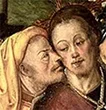
The kiss of betrayal
Rodrigo de Osona, father and Francisco de Osona, son collaborated in the painting of this oil-on-panel painting titled The Taking of Christ, on view at Museo del Prado in Madrid. The work of these Spanish Renaissance painters represents the moment when Jesus Christ was arrested by the Jewish authorities, after he received a betrayal kiss from Judas Iscariot (shown left). “This and five other panels at the Prado Museum are some of the finest examples of the collaboration between Rodrigo and Francisco de Osona. They were probably designed as part of an altarpiece. The placement and physiognomy of the figures are in keeping with the style of this family of painters from Valencia.”[1]
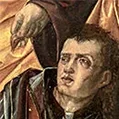
Jesus holds Malchus’ ear.
After Jesus prayed, Judas arrived with many soldiers, high priests, Pharisees, and servants to arrest Jesus, identifying him by a prearranged kiss. Trying to protect him, Peter drew a sword and attacked a man named Malchus, the high priest’s servant, cutting off his right ear. Jesus rebuked Peter and healed the man’s ear, displaying God’s miraculous power (Luke 22:51). Even though this incident is recorded in all four gospels, Matthew 26:51; Mark 14:47; Luke 22:51; and John 18:10–11, the servant and the disciple are named as Malchus and Simon Peter only in John. And only Luke records that Jesus healed the servant. The Osona’s rendition of Peter cutting off the ear of Malchus is one of the very few artworks that show Jesus holding the ear prior to replacing it and healing the injury (shown right).
… Height: 49.6 in. (126 cm), width: 33 in. (84 cm)
… Photo source, license attribution, museum details, and image enlargement: Museo del Prado, Madrid
… The artists’ short biography; other artworks by Rodrigo de Osona and Fransisco de OsonaReturn to “Peter Masterpieces” album’s opening page or to the top of this page or open the next album.
- 28. “Christ Taken Prisoner in the Garden,” engraving, by Grégoire Huret, 1664
Christ Taken Prisoner in the Garden is an engraving that Grégoire Huret (1606–1670), an architect, painter, and printmaker, who began engraving at a young age, created as part of his The Passion of Christ series. This engraved print from 1664 is plate 8 (marked in the footer).
The footer’s Latin text, translated into English: “Who is it you want?” They answered him: “Jesus of Nazareth.” Jesus says to them: “I am he.” When Jesus said, “I am he,” they drew back and fell to the ground. Again he asked them again, “Who is it you want?” They said, “Jesus of Nazareth.” Jesus answered, “I told you that I am he. If you are looking for me, then let these men go” (John 18:5–8). Then the detachment of soldiers with its commander and the Jewish officials arrested and bound Jesus (vv. 12–13).
Herein, Huret adds a seldom-presented element of this capture episode. In addition to highlighting the usual betrayal kiss by Judas and the sword that Peter brandished, Huret documents Scripture’s account. Standing before the many soldiers was Jesus, an unarmed Jewish rabbi wearing only his simple prayer shoal while displaying radiance and authority that they couldn’t recognize and appreciate. The soldiers, having worldly weapons and authority, expected Jesus to cower in fear. Instead, when he stated, “I am he,” the soldiers began to fall to the ground; they were knocked flat by the power of God.
… Height: 19 15/16 in. (50.6 cm), width: 14 1/16 in. (35.7 cm)
… Photo source, license, attribution, museum details, and image enlargement: public domain, via The Met; Harris Brisbane Dick Fund, 1953
… No Huret biography found; view his other works of art
Return to “Peter Masterpieces” album’s opening page or to the top of this page or open the next album. - 29. “The Betrayal of Christ,” tempera on poplar panel, painted by Il Sassetta (Stefano di Giovanni), 1437–1444
Il Sassetta (Stefano di Giovanni) painted The Betrayal of Jesus between 1437 and 1444 using tempera and silver and gold leaf on poplar panel. It had been part of a large altarpiece (16 feet high, 20 feet wide) that was decorated front and back with sixty paintings for a Franciscan church in the small Tuscan town of Borgo San Sepolcro. Originally placed on that high altar, it’s a “lost” Italian Renaissance altarpiece. According to virtual reconstruction of the now dismembered altarpiece, this Betrayal of Jesus panel was on the front predella (the base) of this polyptych altarpiece. You can see the detailed virtual reconstruction of the front panels (item #15). It’s now on view at Detroit Institute of Arts.
Interestingly, Sassetta included a few atypical elements of the betrayal and arrest episode of Jesus’ Passion. In addition to the traditional “Judas kiss” (centered) and haloed Apostle Peter cutting off the right ear of Malchus, a servant of the high priest, the artist highlighted these few seldom-seen instances:
(1) While Jesus looks straight at Judas, the haloed Lord also points his finger directly at Peter, to rebuke him for his violent action; (2) to the right, nine haloed apostles collectively flee the scene in haste; and (3) a part of the head of the eleventh haloed apostle can be seen departing on his own behind the large boulder. Of all four gospels, only Mark’s account suggests that he himself might be that young fleeing apostle: “A young man, wearing nothing but a linen garment, was following Jesus. When they seized Jesus, the man fled naked, leaving his garment behind” (Mark 14:51–52).
… Height: 14 5/16 in. (36.4 cm), width: 23 5/16 in. (59.2 cm)
… Photo source, license, attribution, museum details, and image enlargement: Stefano di Giovanni, public domain, via Wikimedia Commons
… The artist’s short biography; see his other works of art
Return to “Peter Masterpieces” album’s opening page or to the top of this page or open the next album. - 30. “The Arrest of Christ,” oil on oak panel, painted by Master of Dreux Budé Triptych, c. 1450
The Master of the Dreux-Budé Triptych, probably André d’Ypres, painted this oil-on-oak panel as part of the Dreux-Budé Triptych, now in Musée du Louvre, Paris. This complex narrative was once the left-wing panel of a portable, three-part altarpiece devoted to Christ’s Passion. “The Louvre paid £965,000 ($1.175 million) in 2015 for this small panel, which was commissioned in the mid-15th century by the prominent Parisian merchant Dreux Budé. The triptych’s three main panels are scattered: The central one is in the Getty, Los Angeles; the right wing is in the Musée Fabre at Montpellier, France; but the Louvre’s new purchase will join another work, The Crucifixion of the Parlement of Paris, which is believed to be the design of the same artist.”[1]
“The subject (related in Matthew, chapter 26) is set under a starry night sky with a crescent moon. The high priest’s servant in the immediate foreground, who has just had his ear lopped off by an unnamed disciple [presumably Peter], fumbles on his knees for his broken lantern and perhaps his ear, raising his right hand to the wound while his severed ear is close to Christ’s foot. As one might expect, there’s no light source on Christ’s face as he receives the kiss of Judas, since Jesus is the light source of the world. Christ appears twice in this painting: As an infant (left-rear), he sits on Saint Christopher’s shoulders.”[2]
See many more “capture/arrest/betrayal of Jesus” painted masterpieces.
… Height: 16 in. (40.8 cm), width: 12 in. (30.5 cm)
… Photo source, license, attribution, museum details, and image enlargement: Master of Dreux Budé, public domain, via Wikimedia Commons
Return to “Peter Masterpieces” album’s opening page or to the top of this page or open the next album. - 31. “The Capture of Christ, with the Malchus Episode,” oil on canvas, painted by Dirck van Baburen, 1616–1617
This oil-on-canvas painting, titled The Capture of Christ, was painted by Dirck Jaspersz. van Baburen around 1616. “This is one of his rare nocturnal scenes, inspired in part by Caravaggio’s “Taking of Christ” [shown in slide 13 of this album]. Van Baburen, like Caravaggio, preferred strong patterns of natural daylight. This Golden Age Dutch painter (original name: Theodor Baburen) was a leading member of the Utrecht school.”[1]
Do you see the man called Judas Iscariot? He’s the bearded man in the center, facing Jesus. The artist has included only basic elements to this two-fold biblical account: Judas, with his hand on Jesus’ left shoulder, has already betrayed his Lord Jesus by kissing him, as he’d prearranged with the chief priests (Matthew 26:14–16); only two or three of the “large crowd armed with swords and clubs” (Matt. 26:47) are physically arresting Jesus; at the right, having already cut and lobbed off the right ear of a high priest’s servant named Malchus, Peter looks directly at Jesus who has just rebuked him for his violent, unilateral act: “Put your sword back in its place,” Jesus said to him, “for all who draw the sword will die by the sword” (v. 52).
“Judas was one of the original twelve disciples who followed and were taught by Jesus. Being in Jesus’ ‘inner circle,’ Judas had a closer relationship to Jesus than most people during His ministry. Judas betrayed the Lord to the Jewish authorities. The prearranged signal was that the person whom Judas kissed was to be arrested and taken away (Mark 14:44). In this way the Son of Man was betrayed with a kiss (Luke 22:48).”[2]
… Height: 49.2 in. (125 cm), width: 37.4 in. (95 cm)
… Photo source, license, attribution, museum details, and image enlargement: Dirck van Baburen, public domain, via Wikimedia Commons
… The artist’s short biography; his other works of art
Return to “Peter Masterpieces” album’s opening page or to the top of this page or open the next album. - 32. “Christ Taken Prisoner,” tempera on wooden altarpiece panel, painted by Duccio di Buoninsegna, 1308–1311
One of the greatest Italian painters of the Middle Ages, Duccio di Buoninsegna (1255–1318), painted the famous lorenz polyptych altarpiece, which was “commissioned by the Siena Cathedral in 1308 and completed in 1311. Today, most of this elaborate double-sided altarpiece is in the Museo dell'Opera del Duomo, an art museum in Siena. But several of the predella [base-level] panels are scattered outside Italy in various museums. This is probably the most important panel ever painted in Italy; certainly among the most beautiful.
“All of the front of the main panel is occupied by a scene of the Virgin and Child in majesty (shown here), surrounded by angels and saints; corresponding to this on the back are twenty-six scenes from Christ’s Passion, which is a story that’s composed of different chapters of the gospels.”[1] This Christ Taken Prisoner painting is panel #7 on this numbered grid of the altarpiece’s rear.
Duccio’s painted panel includes traditional iconography for this famous episode of Jesus’ Passion. In its center, Judas kisses haloed Jesus; behind them are members of the crowd, including “a detachment of soldiers and some officials from the chief priests and the Pharisees. They were carrying torches, lanterns and weapons” (John 18:3); to the right, several haloed apostles depart the scene; and at the left, unhaloed Peter has just lobbed off the right ear of Malchus, a servant of a high priest (see enlarged detail). [To see many more of Duccio’s Maestà creations that feature Peter, open Warren Camp’s Albums #2, 4, 8, 9, 13, 14, and 15.]
… Panel height: 20 in. (51 cm), width: 30 in. (76 cm)
… Photo source, license attribution, museum details, and image enlargement: Duccio di Buoninsegna, public domain, via Wikimedia Commons
… The artist’s short biography; his other works of art
Return to “Peter Masterpieces” album’s opening page or to the top of this page or open the next album. - 33. “Capture of Christ,” painted on fir altarpiece panel by Meister des Andreasaltars, 1445–1450
The Master of St Andrew’s Altar (Meister des Andreasaltars) painted this altarpiece panel titled Capture of Christ. It can be seen at the Belvedere Museum in Vienna. The artist is named after an altar dedicated to St Andreas, from before 1440 (now kept at the Cathedral and Diocesan Museum in Vienna). Nothing more about this 15th-century artist could be found.
Chapter 18 of John’s gospel moves from Jesus’ Last Supper prayer, which he prayed to Father God in the upper room, directly to Gethsemane (Hebrew for “olive press”), a garden that he and his disciples entered often. In Luke’s account, we learn that Jesus and his disciples had repeatedly spent the night there on the Mount of Olives (Luke 21:37; 22:39). The detachment of soldiers and officials from the chief priests and the Phariseese who came to arrest Jesus said that they sought Jesus of Nazareth.
Of the traditional iconography usually included in like-kind renditions, the Master herein highlights Judas (center) betraying Jesus with a kiss. Other expected elements are also included, such as: armed temple guards wearing helmets and armor while carrying weapons and lanterns; and Peter (left-center) raising his sword, preparing to cut off kneeling Marchus’ ear, which Christ cares for and holds in his right hand.
… Height: 42 1/2 in. (108 cm), width: 28 1/4 in. (71.8 cm)
… Photo source, license, attribution, museum details, and image enlargement: Meister des Andreas-Altars, public domain, via Wikimedia Commons
Return to “Peter Masterpieces” album’s opening page or to the top of this page or open the next album. - 34. “The Betrayal of Christ,” print engraved by Hendrick Goltzius, 1598
Hendrick Goltzius (1558–1617) “was a German-born Dutch printmaker, draftsman, and painter. The leading Dutch engraver of the early Baroque period, or Northern Mannerism, Goltzius is lauded for his sophisticated technique, technical mastership, and ‘exuberance’ of compositions. Hollstein credits 388 prints to him, with a further 574 by other printmakers after his designs.”[1]
“During his lifetime, Goltzius became celebrated throughout Europe as an extraordinary artist who could observe, copy, and then surpass the works of earlier masters, including Dürer. Goltzius’s Passion series of 1596–1598 includes several episodes, The Betrayal of Christ among them, which clearly derive inspiration from the composition and clarity of earlier artists’ engraved versions. In this theatrical interpretation, Goltzius extended the landscape in the background and amplified the nocturnal effect by adding twinkling stars to the sky, as well as a large lantern held directly over Christ’s head.”[2]
“Between 1596 and 1598, Goltzius engraved a series of twelve prints illustrating the Passion of Christ, which was extremely popular during Goltzius’s own lifetime and well beyond.”[3] Note the added element (right-rear) of a young unclothed man fleeing the arrest scene. Mentioned only in Mark’s gospel, it could be Mark himself: “A young man, wearing nothing but a linen garment, was following Jesus. When they seized him, he fled naked, leaving his garment behind” (Mark 14:51–52).
… Height: 7 7/8 in. (20 cm), width: 5 1/8 in. (13 cm)
… Photo source, license, attribution, museum details, and image enlargement: The Met; The Elisha Whittelsey Collection, Elisha Whittelsey Fund, 1951
… The artist’s short biography; his other works of art
Return to “Peter Masterpieces” album’s opening page or to the top of this page or open the next album. - 35. “Judas’ Kiss (Judaskus)” print, engraved by Philips Galle (school of), 1586–1586, after Jan van der Straet
Philip (or Philips) Galle (1537–1612) “was a draughtsman, engraver, publisher, print dealer, writer and historian. The Galles were a Flemish family of artists and publishers. The print workshop and publishing house founded by Philip was one of the most important engraving centers in Antwerp from the late 16th century to the early 17th. The business was continued by his sons Theodor and Cornelis I (seen in the next slide), who are chiefly known as reproductive engravers after compositions by Rubens”[1]
This Judas’ Kiss (Judaskus) engraving, number 330, is part of Galle’s “Passion, Death and Resurrection of Christ” series. Following a Jan van der Straet design, Galle portrays Judas hugging and kissing haloed Christ’s cheek. Of the three apostles on the left, Galle places Peter in the center, holding his sword. Soldiers (right) armed and carrying lit lanterns approach Jesus to arrest him but, “When Jesus said, ‘I am he,’ they drew back and fell to the ground” (John 18:6).
The print’s Latin caption reads in English: “And he waited to be taken captive by a false-hearted friend whom he could lay low by his will or by his word; the man had given an insincere kiss under the guise of peace.”
… Height: 10.4 in. (265 mm), width: 7.6 in. (192 mm)
… Photo source, license, attribution, museum details, and enlargement: Rijksmuseum Amsterdam; purchased with the support of the FG Waller-Fonds
… The artist’s short biography; his other works of art
… There are sixteen Galle engravings of Apostle Peter in “Peter Masterpieces”: Album 3 (3@); 5 (4@); 6 (2@); 7 (5@); 10; and 14.
Return to “Peter Masterpieces” album’s opening page or to the top of this page or open the next album. - 36. “Captivity of Christ,” print engraved by Cornelis Galle, 1586–1650
Cornelis Galle the Elder (1576–1650), a younger son of Philip Galle, was born at Antwerp, Belgium. He was taught engraving by his father.
This small vertical engraving (print #4 in a series of 13, exhibited at Rijksmuseum Amsterdam) is titled Captivity of Christ. It’s from his “Passion” series. Similar to his father Philip’s larger horizontal engraving [see previous slide] titled “Judas’ Kiss,” here Judas hugs and kisses Christ on the cheek in a prearranged act of betrayal of him to the soldiers. While armed soldiers approach the two from the rear, we see Simon Peter in the foreground, raising his sword over Malchus the slave or servant of the high priest. Simon Peter is about to cut off the fallen servant’s ear. And, as his father had done, Cornelis includes a naked man (left-background) fleeing the scene.
Translating the Latin footer to English: “Jesus is handed over with a kiss from Judas.” Jesus’ arrest was organized by Christ’s disciple, Judas Iscariot, who looks intently at Jesus, preparing to betray him with a kiss — an agreed-on signal for the authorities: ‘Now the betrayer had arranged a signal with them: ‘The one I kiss is the man; arrest him and lead him away under guard.’ Going at once to Jesus, Judas said, ‘Rabbi!’ and kissed him’ (Mark 14:44–45). As this is happening, Jesus focuses his attention on Peter’s raised hand that brandishes a sword; Jesus will rebuke Peter, after seeing him use his sword to assault that man.
… Height: 5 1/4 in. (133 mm), width: 3 2/3 in. (92 mm)
… Photo source, license attribution, museum details, and image enlargement: Rijksmuseum Amsterdam; gift of GJ Boekenoogen, Leiden
… The artist’s short biography; his other works of art
Return to “Peter Masterpieces” album’s opening page or to the top of this page or to the start of Warren Camp’s next page: Album 15
“Peter” Has Indeed Left an Artistic Mark on Our World
In these albums, see numerous “Peter Masterpieces” created by renowned art masters from around the world.
• Album 1: “Peter, Alone” (29 images)
• Album 2: “Calling Apostle Peter” (12@), “Preaching the Gospel” (6@), and “Powerful Pentecost” (16@)
• Album 3: “Peter’s Presence with Other Apostles” (28@) and “Walking on Water” (7@)
• Album 4: “Receiving the Keys of Heaven” (15@), “Transfiguration” (8@), and “Tribute Money” (14@)
• Album 5: “Peter Heals People” (23@) and “The Miraculous Catch of Fish” (13@)
• Album 6: “Peter Gets Freed from Prison” (30@)
• Album 7: “Miscellaneous New Testament Depictions of Peter” (35@)
• Album 8: “Christ Washes Peter’s Feet” (26@)
• Album 9: “The Last Supper — Part 1” (33@ of 136)
• Album 10: “The Last Supper — Part 2” (35@ of 136)
• Album 11: “The Last Supper — Part 3” (34@ of 136)
• Album 12: “The Last Supper — Part 4” (34@ of 136)
• Album 13: “Christ’s Agony in the Garden” (32@)
• Album 14: “Judas’ Kiss,” “Jesus’ Betrayal,” and “Malchus’ Ear” (36@)
• Album 15: “Peter Denies Knowing Christ” (32@)
• Album 16: “Repentant Peter” (17@) and “Peter’s Martyrdom/Crucifixion” (17@)
• • • And, in Album 17, see “Stained Glass Windows Featuring Saint Peter” (34@)
Intro Videos: “First Peter” and “Second Peter”
† Watch this summary video of “First Peter” created by BibleProject.
† Here’s the “Second Peter” summary video created by BibleProject.
• Special Presentation: See more than sixty of Warren Camp’s “Peter Masterpieces” on this 4-minute video clip titled “Holy Week through 100 Paintings,” produced by Christian Art.
